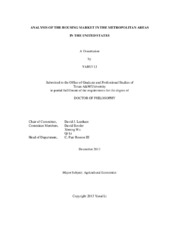Analysis of The Housing Market in the Metropolitan Areas in the United States
Abstract
The housing market plays a significant role in shaping the economic and social well-being of U.S. households. It helps spur U.S. economic growth when house prices rise, and drags the economic growth when house prices drop. In this dissertation, an analysis is conducted to project the direction of the U.S. housing market and to discover how it interacts with economic fundamentals. New pieces of information are found, which are deemed to facilitate decision making for both policy makers and investors.
In the first part of the dissertation, the groupings of U.S. housing markets are studied using cluster and discriminant analysis. Three clusters are found, which are located in the central, the east coast, and the west coast of US. There are no price signals transmitted among these housing market clusters, nor within each cluster. Thus, the communication of information in the housing market is through the process of utility convergence of marginal residents, and no price convergence across regions is found.
Next, the impact of credit constraint on the house prices is examined with the stochastic components of the price series being considered. Both a simulation technique and a DAG approach are employed. The resulting causal pattern shows that credit constraints affect the house prices directly and positively. Moreover, credit constraints work as an intermediary, passing the influence of the house investor, household income, and user cost onto house prices, which suggests that the credit relaxation policy should be carried out with caution when house inventory and household income send inconsistent signals.
Last, the model selection for house price analysis is discussed from the perspective of large-scale models—dynamic factor (DFM) model and large-scale Bayesian VAR (LBVAR) model. The LBVAR models are found to have superior performance compared to the DFM model throughout the prediction period. Also, it is found that the combined forecasts do not necessarily outperform individual forecasts. Even though independent information from different individual models improves the forecast accuracy, the benefit gained from marginal information is offset by the larger error brought by such combination.
Citation
Li, Yarui (2013). Analysis of The Housing Market in the Metropolitan Areas in the United States. Doctoral dissertation, Texas A & M University. Available electronically from https : / /hdl .handle .net /1969 .1 /151894.


